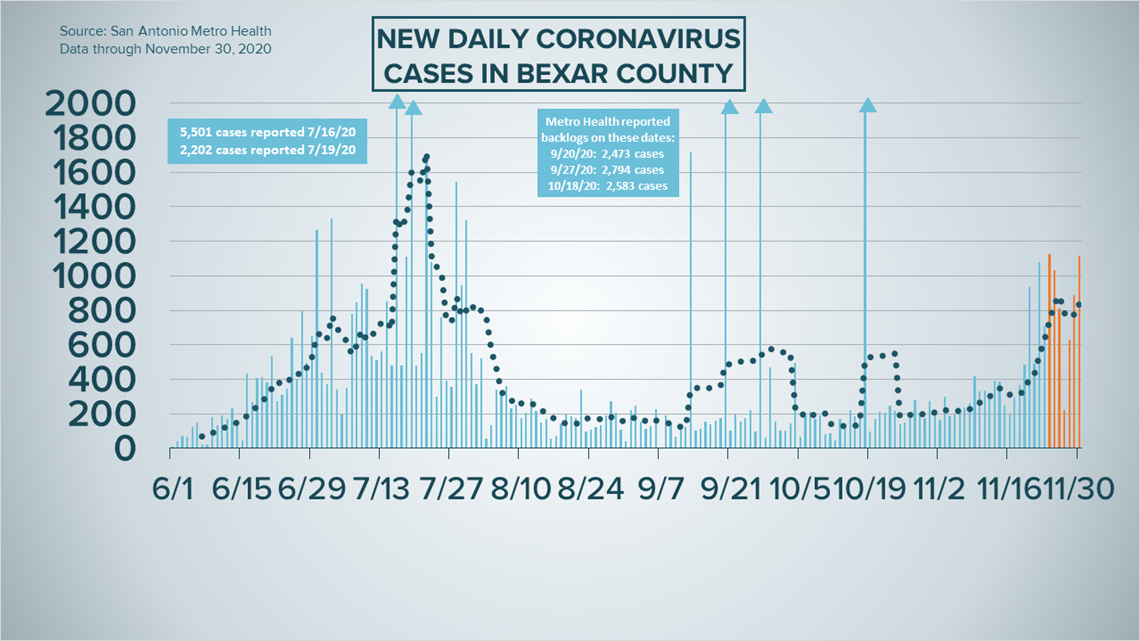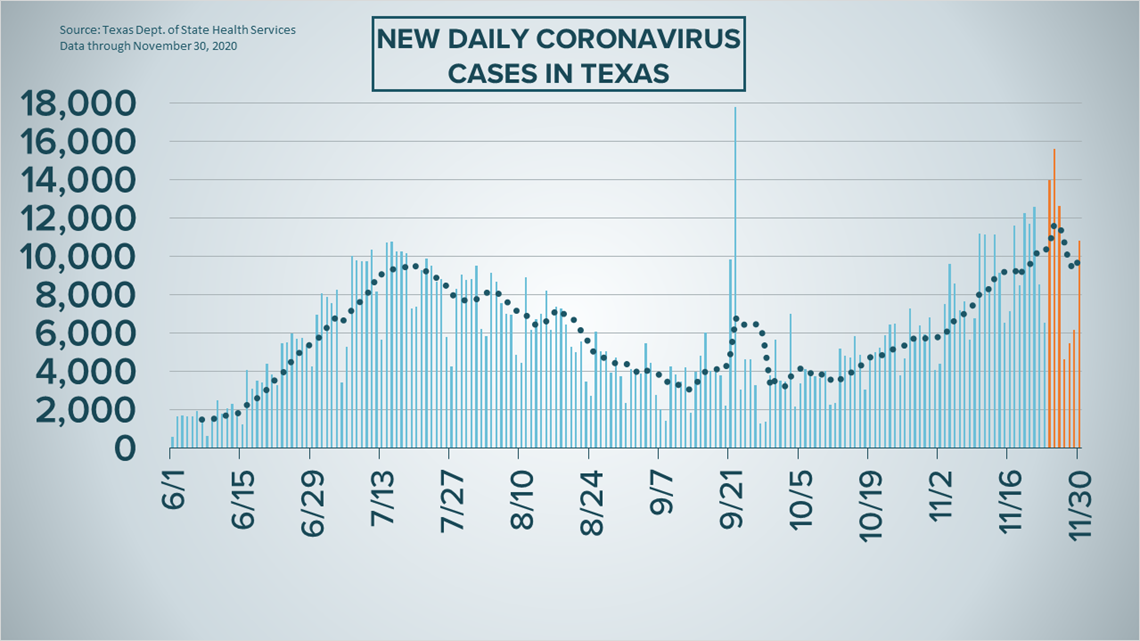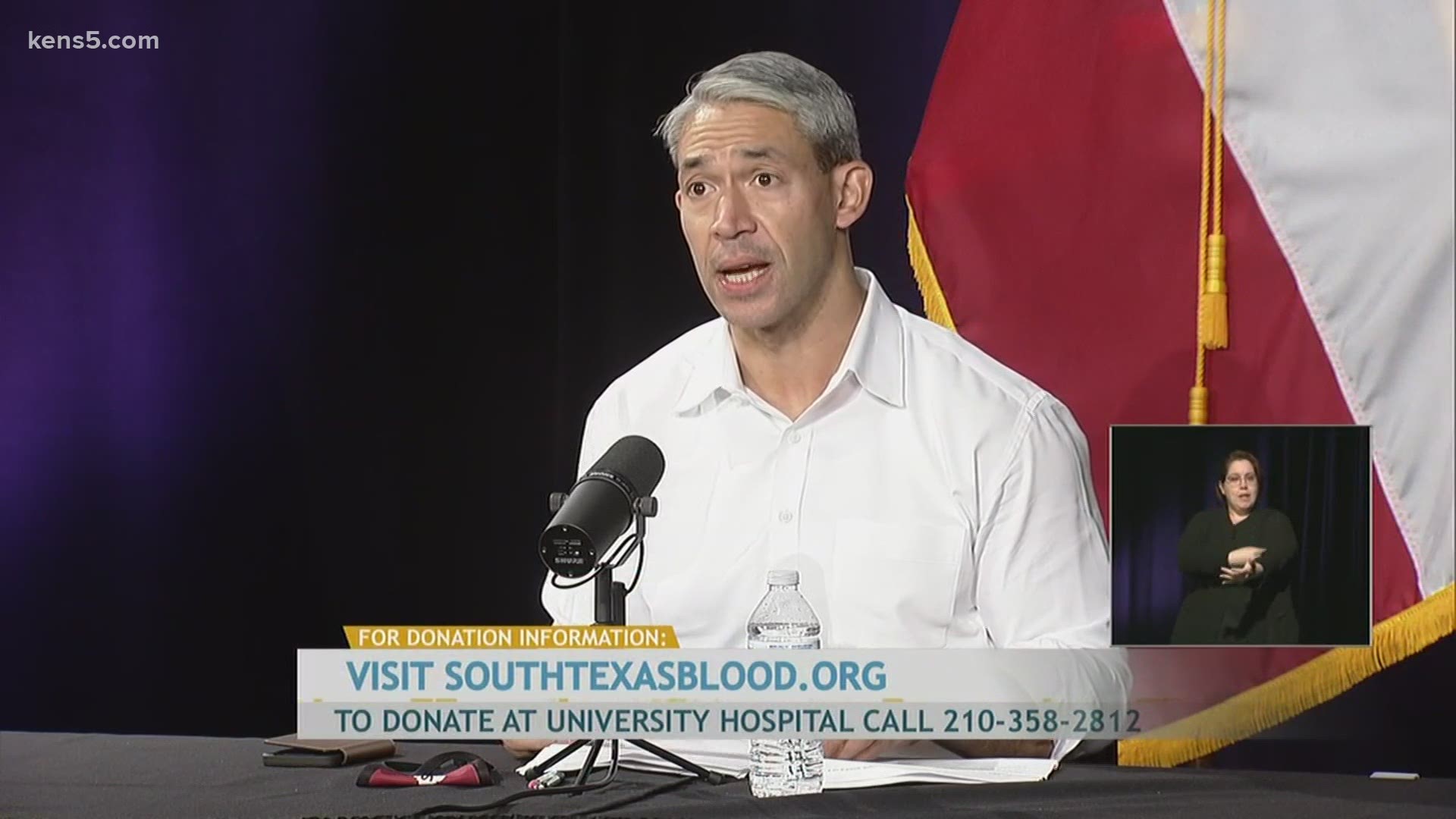SAN ANTONIO — We're tracking the latest numbers from the coronavirus pandemic in San Antonio and across Texas. Here are the latest numbers reported by Bexar and surrounding counties:
- Bexar County: 1,117 new cases were reported on Monday, bringing the total number of cases to 81,174. No new deaths were reported, raising the death toll to 1,357.
- Hays County: Officials in Hays County on Monday reported 281 new cases in the county and three additional COVID-related fatalities in their first report since before Thanksgiving. As of Monday, there are a total of 7,378 lab-confirmed cases in the county (772 of which are active), while the death toll rose to 102. 6,504 residents have recovered from the virus.
More county case information is available through the Texas Department of Health Services COVID-19 dashboard.
How Bexar County is trending
We've tracked how many coronavirus cases have been confirmed in Bexar County from the time officials began reporting cases in March 2020. The graphic below shows the number of cases since June and charts those daily case numbers along a 7-day moving average to provide a more accurate picture of the overall coronavirus case curve in our area and the direction we're trending amid the pandemic.
On Monday evening, San Antonio Mayor Ron Nirenberg reported an additional 1,117 coronavirus cases in Bexar County. In all, 81,174 county residents have been diagnosed with COVID-19.
The seven-day moving average for daily cases is at 832. That number rose by 315% over the month of November.


Nirenberg reported no new virus-related deaths Monday. In all, 1,357 county residents have died from coronavirus complications.
Meanwhile, the number of local COVID-19 patients in area hospitals jumped up by five to 587, the highest that number has been since August 17. Of those, 99 patients are on ventilators while 182 are in intensive care.
About 15 percent of COVID-19 patients in Bexar County hospitals are transports from El Paso.


During Monday's update on the city's warning indicators, Nirenberg noted that the risk level in San Antonio has risen to "worsening" behind a steady rise in daily cases as well as increased stress in hospitals.
The local positivity rate dropped, however, from 10% to 9.2%; Nirenberg noted that the drop was likely due to a large number of asymptomatic residents getting tested before the Thanksgiving holiday.
Coronavirus in Texas
The total number of novel coronavirus cases in the state since the pandemic began grew by 10,838 on Monday, according to the Texas Department of State Health Services.
That total includes 10,714 new confirmed cases and 124 cases attributed to backlogs not previously reported in the state's total (more details can be found at the top of this page).
As of Monday, 1.22 million Texans have been diagnosed with COVID-19. Of those, 1.17 million diagnoses are confirmed via molecular testing, while another 52,625 are positive antigen tests.


State health authorities also reported 22 additional virus-related deaths on Monday. At least 21,379 Texans have died from COVID-19 complications.
The number of COVID-19-related hospital patients, meanwhile, rose by 266 over the past 24 hours to 8,900, the highest since August 1. Hospitalization numbers still remain on the upswing, continuing a trend first glimpsed in the Lone Star State nearly two months ago. Over the month of November, hospitalizations increased by 53%.
Meanwhile, the state estimates that 962,639 Texans have recovered from COVID-19.
The latest update from the Texas Education Agency showed that there have been 50,420 cumulative cases among staff and students across the state through Nov. 15. More information can be found here.
The TEA typically releases new data on school cases every Thursday but not did do so on the Thanksgiving holiday. Officials said the latest numbers will be reported next week.
Latest Coronavirus Headlines
- Back from the holidays? Here's why and where you should get tested for coronavirus
- NEISD now offering free curbside coronavirus testing for students and employees
- 'This is not fake news': Dr. Fauci talks holiday travel safety and upcoming vaccines in 1-on-1 interview
- TSA numbers show Thanksgiving eve travel at less than half that of last year
- Beware of COVID-19 scams as vaccine approaches FDA approval
Coronavirus symptoms
The symptoms of coronavirus can be similar to the flu or a bad cold. Symptoms include fever or chills, cough, shortness of breath or difficulty breathing, fatigue, muscle or body aches, headache, new loss of taste or smell sore throat, congestion or runny nose, nausea or vomiting and diarrhea, according to the Centers for Disease Control.
Most healthy people will have mild symptoms. A study of more than 72,000 patients by the Centers for Disease Control in China showed 80 percent of the cases there were mild.
But infections can cause pneumonia, severe acute respiratory syndrome, kidney failure, and even death, according to the World Health Organization. Older people with underlying health conditions are most at risk.
But infections can cause pneumonia, severe acute respiratory syndrome, kidney failure, and even death, according to the World Health Organization. Older people with underlying health conditions are most at risk.
Experts determined there was consistent evidence these conditions increase a person's risk, regardless of age:
- Chronic kidney disease
- COPD (chronic obstructive pulmonary disease)
- Obesity (BMI of 30 or higher)
- Immunocompromised state (weakened immune system) from solid organ transplant
- Serious heart conditions, such as heart failure, coronary artery disease, or cardiomyopathies
- Sickle cell disease
- Type 2 diabetes
The CDC believes symptoms may appear anywhere from two to 14 days after being exposed.
Human coronaviruses are usually spread...
- Between people who are in close contact with one another (within about 6 feet).
- Through respiratory droplets produced when an infected person coughs, sneezes or talks. These droplets can land in the mouths or noses of people who are nearby or possibly be inhaled into the lungs.
- Some recent studies have suggested that COVID-19 may be spread by people who are not showing symptoms.
Help stop the spread of coronavirus
- Stay home when you are sick.
- Eat and sleep separately from your family members
- Use different utensils and dishes
- Cover your cough or sneeze with your arm, not your hand.
- If you use a tissue, throw it in the trash.

